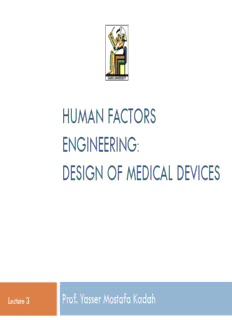
Part II - Chapter 7 - lecture presentation of November 28, 2010 PDF
Preview Part II - Chapter 7 - lecture presentation of November 28, 2010
HUMAN FACTORS ENGINEERING: DESIGN OF MEDICAL DEVICES Prof. Yasser Mostafa Kadah Lecture 3 Anthropometry and Biomechanics Understanding of human physical capabilities and limitations is fundamental to the design of effective medical devices Anthropometry is the science of measuring and quantifying various human physical traits, such as size, weight, proportion, mobility, and strength. Biomechanics is the use of laws of physics and engineering principles to study various body segments as they move and are acted upon by internal and external forces Most of the anthropometric and biomechanical information available today is not specific to health care professionals, patients, or medical devices General Considerations Medical device design should account for the physical sizes of people Data on body-size distributions of males and females Reference information for tools used to assess the risk of musculoskeletal injury associated with work performed in clinical environments Medical domain has unique anthropometric challenges Implanted component In some cases, anthropometric information in the public domain is not detailed enough to be of value Example: ear dimensions for headset design (proprietary data) Example: Unilead precordial array used for resting 12-lead ECG Anthropometric Design Guidance Good anthropometric design of medical devices should accommodate as wide a range of human physical dimensions as is possible In most cases, the design of medical tools, equipment, and workstations ought to accommodate adults ranging in size from a 5th percentile female to a 95th percentile male Accommodate larger percentages of the population if a) the device involves critical functions b) there are safety issues associated with not accommodating extremes c) the user population has large physical diversity d) device usability and functionality is not compromised e) the costs of doing so are not excessive Body Measurements Examples Body Measurements Examples Mobility and Functional Measurements Flexibility and mobility Range of motion Functional work Visual Work Strength Several factors could affect the user’s strength potential Factors include (but are not limited to) age, gender, health status, body part, body-part position, direction of exertion, whether the exertion is applied statically or dynamically, posture, and environmental issues Designers should consult references for a summary of guidelines Woodson et al. (1992) provides information related to the ranges of hand strength for adults and children, recommended upper limits for forces commonly used on equipment and in control operations, and lifting and carrying strengths It is seldom appropriate to expect people to exert their maximum strength, which is what the data reported describe A common rule of thumb to avoid complaint is to keep the required force below one-third of maximum strength Special Considerations Disabilities Designing for population extremes Designing for the average user Designing for adjustability Derivation of missing data Ratio-Scaling technique Regression Equation technique Probability Statistics approach Biomechanical Design Guidance Body posture First determine which body part is most relevant to the task, most often used, or most prone to loading or potential injury focus the device design on proper positioning of that joint or body segment Endurance Muscular endurance is a function of the amount of strength exerted by a muscle or group of muscles Repetitive motions Repeated use of the same body part to perform a task is known to increase the risk of musculoskeletal injury
Description: